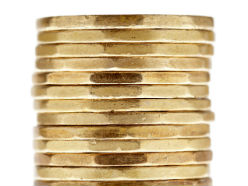
With the loonie recently soaring on the back of the BoC’s rate hike, you might be wondering if another hike — expected this fall — will see the loonie reach even loftier heights.
The short answer: don’t count on it.
Though the loonie’s short-term prospects are good, its performance stems from factors beyond BoC actions, such as rising oil prices.
Also working in the loonie’s favour is underwhelming economic data for the U.S., as well as that country’s unsure political situation, says Desjardins senior economist Mathieu D’Anjou in an economics report.
“The positioning of investors in favour of the loonie may have peaked,” he says. “It is especially difficult to justify the fact that the spread in 2-year yields between Canada and the United States is now practically zero. This assumes that Canadian key rates will, on average, be at least equal to U.S. key rates.”
As the Fed gradually raises rates, D’Anjou expects to see a rise in U.S. bond yields and a return to a more positive view of the U.S. dollar.
Read: The central bank pivot: how far and fast rates could move
Although he expects the BoC to raise rates again in the fall, D’Anjou says the central bank might also “signal its unease regarding the rapid rise in the value of the loonie. This should calm investor enthusiasm somewhat and bring the Canadian dollar back to around US$[0.]79 at the end of 2017.”
Royce Mendes, director at CIBC World Markets, notes in a weekly economics report that Canada’s hot economy has been fuelled by consumer spending, aided in part by the Canada child benefit program, which began in July 2016.
Read: Consumer spending gains annual 3.88% in Q2
Whatever support the program provided has likely been used up, he says, adding that Canada’s economic growth is at an unsustainably high level.
“That makes it all the more important for the Bank of Canada to nurture the nascent export recovery and fend off a stronger loonie,” he says.
Read the Desjardins report and the CIBC report.
Also read: